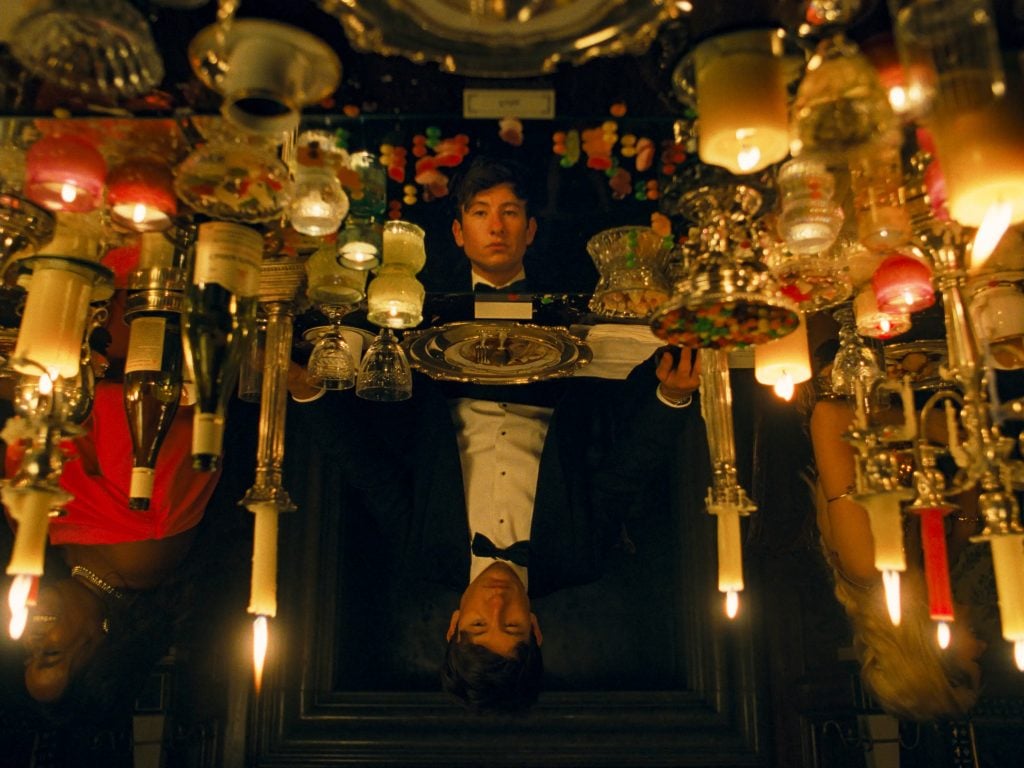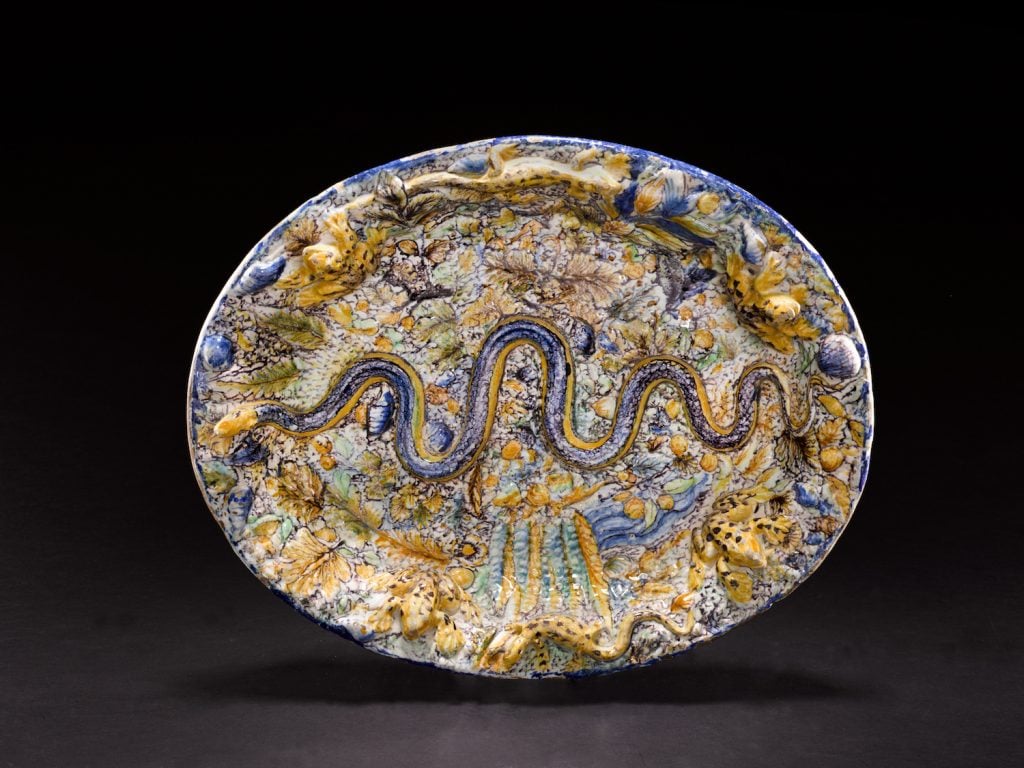Pop Culture
How the Provocative ‘Saltburn’ Is Renewing Interest in a 400-Year-Old French Ceramicist
The new film sees Bernard Palissy, the 16th-century Huguenot, play a subtle yet significant role.

The new film sees Bernard Palissy, the 16th-century Huguenot, play a subtle yet significant role.

Eileen Kinsella

It’s a safe bet that, up until a few weeks ago, most of the world was not familiar with the word Palissy—the name behind a centuries-old series of French ceramics known for their wildly colorful palettes inspired by plants and flowers, often affixed with three-dimensional casts of crabs, snakes, fish, frogs, and lizards, to name a few creatures.
But the viral success of the newly released Saltburn, a gothic, intrigue-riven Talented Mr. Ripley-esque tale set in the English countryside, is quickly changing that. The class-skewering movie involves a wealthy Oxford student named Felix Catton, played by Jacob Elordi, who takes pity on a less fortunate student with the Dickens-esque name of Oliver Quick, played by Barry Keoghan, and invites him to Saltburn, his family estate, for the summer.
So, what is Palissy’s significance in the film? A Palissy plate, which we only see in a lightening quick shot, is the focus of a small but important subplot in which Quick first uses it to boast that he knows his Palissy.
“Do you mean Bernard Palissy? The 16th-Century Huguenot ceramicist?” Quick piped up when the plate is brought up.
“You know him?” the family’s patriarch, Sir James Catton, asked incredulously.
“Yes,” responded Quick. “I’ve always loved his work but I’ve never seen anything of his in real life.”

Barry Keoghan in Saltburn (2023). Photo courtesy of MGM and Amazon Studios. © Amazon Content Services LLC.
So, who or what, then, is Palissy?
The name is indeed a reference to a multi-hyphenate, talented Frenchman named Bernard Palissy (ca. 1510–90) who, in addition to his remarkable ceramic work, had expansive interests not limited to geology, religious reform, glassblowing, philosophy, painting, and writing.
Palissy was known as an outspoken Huguenot, and was imprisoned for his religious beliefs and his involvement in the Protestant riots of the first of the Wars of Religion. It was only because of the assistance of Anne de Montmorency, a powerful Catholic patron, that he obtained amnesty. Later, French Queen Catherine de’Medici not only protected him, but commissioned him to build a private grotto for her at the garden of the Tuileries palace.

Palissy, an English delftware large oval dish with a large snake, (circa 1635-50) “Southwark, probably Pickleherring Quay” sold at Sotheby’s London on July 5, 2022 for $75,000 (£63,000). Image courtesy Sotheby’s.
In Saltburn, the valuable Palissy plate comes up again and more prominently when it is used to impugn Farleigh, an arrogant relative of the Catton family who is also summering at the estate. At one point, Farleigh is accused of trying to “nick” something, specifically the Palissy.
“He sent an email to Sotheby’s to say he’d ‘come by’ some Palissy plate,” Felix explained. “I mean, the idiot! He’d had to have known that Dad went to school with the chairman!”
Actual Palissy pieces are so rare that an entire industry and market has formed around “followers” of and artisans who were inspired and influenced by his practice of attaching casts of dead animals to traditional ceramic forms such as basins, ewers, and plates. The Metropolitan Museum of Art, for instance, has a signature platter from the 16th-century in its collection in which the artist is clearly labeled “Follower of Palissy.” There is also an eponymous Bernard Palissy museum in Lacapelle-Biron, France.
A search of the Artnet Price Database reveals more than 600 entries of works offered at auction over the years and how pricey they can be. One of the highest prices achieved at auction was $88,200 for a green “Post-Palissy” earthenware pitcher or “ewer” measuring 12.4 inches high and dated 1600-1699. It sold online at Christie’s this past October.

Source: Artnet Price Database
The next highest price in the database is for a Palissy “English delftware large oval dish with a large snake, dated circa 1635–50 and labeled “Southwark, probably Pickleherring Quay” that sold at Sotheby’s London last July for $75,000 (£63,000).
Saltburn, it seems, has sparked fresh interest in Palissy, a name that is far more obscure than some of the others thrown about during the film (Felix casually points out some “bad Rubens” during a tour of the family mansion). Since the film’s release, fans have delivered some entertaining and insightful Palissy explainers on social media.
One, a TikTok user @meelzonart, astutely observed: “Now, these plates were very influential… many people copied the style of Palissy-ware but something from around 1600… would go for about €63,000, so these are very very expensive and they represent not only an artistic practice but a collection of fine porcelain or ceramics that circulates within very aristocratic or ultra-wealthy crowds, like Felix’s family.”
More Trending Stories:
Art Dealers Christina and Emmanuel Di Donna on Their Special Holiday Rituals
Stefanie Heinze Paints Richly Ambiguous Worlds. Collectors Are Obsessed
Inspector Schachter Uncovers Allegations Regarding the Latest Art World Scandal—And It’s a Doozy
Archaeologists Call Foul on the Purported Discovery of a 27,000-Year-Old Pyramid
The Sprawling Legal Dispute Between Yves Bouvier and Dmitry Rybolovlev Is Finally Over